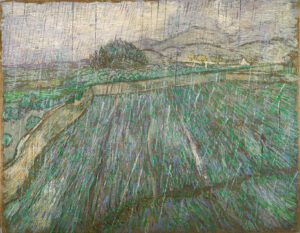I heard my first cicada song early Tuesday morning: one sole insect, somewhere in the stands of bamboo in the yard, making that raspy sound that cicadas make. It’s mid-July. The days here in Lake Worth are hot and languid; the nights are, too, and the cicadas will grow in number these next few weeks and their chorus will grow louder and louder. This is high summer in Florida, and if the season had backing music and a soundtrack, the cicadas would be the orchestra performing it.
We’ve been in the midst of a relentless heat wave, with highs each day in the 90s, and let me tell you: there is a big difference between 89˚ and 93˚. One is bearable; the other, much less so. But it’s also our rainy season, and an evening thunderstorm rolling through will make for a rain-cooled night and that can make life so much lighter here.
A bit of rain is generally a daily constant here this time of year. And now it is the Fifteenth of July, which brings a traditional weather marker that you’d think originated here in this dripping green land, but no, it’s from England. It’s St. Swithin’s Day, and this is how the story goes: St. Swithin’s Day if thou dost rain, For forty days it will remain; St. Swithin’s Day if thou be fair, For forty days ’twill rain nae mair.
St. Swithin is known as the weeping saint. He was a 9th century Anglo-Saxon bishop of Winchester. The source of his weeping comes from after his earthly life, for it was the good bishop’s wish to be buried in the churchyard and not in the chancel of the church, as was the custom for bishops. His wishes were followed when he died, but upon his canonization, the monks there decided the open churchyard was a rather disgraceful place for a saint to be buried, and so on the 15th of July in 971, they planned to move the relics of St. Swithin indoors to the choir, in a solemn procession. A great downpour began during the procession, though, and continued for forty days. The monks took this is a sign from St. Swithin himself, and so they let him be there in the churchyard, although they did eventually erect a chapel over his grave.
It’s not necessarily forty days of constant rain that one might expect. Poor Robin’s Almanack, in July 1697, tells us:
In this month is St Swithin’s Day;
On which, if that it rain, they say
Full forty days after it will,
Or more or less, some rain distill.
Which sounds very much like our South Florida weather this time of year, with our more-or-less daily dose of thunderstorms. John Gay, too, in his poem “Trivia,” gives mention to the saint and legend:
How, if on Swithin’s Feast the welkin hours,
And every penthouse streams with hasty showers,
Twice twenty days shall clouds their fleeces drain,
And wash the pavements with incessant rain.
And those who grow apples love St. Swithin, too, for, they say, he blesses their crops with his tears. And just as St. Swithin fits nicely into our local weather patterns here in Florida, there is some truth, it is said, to the weather lore in the UK for St. Swithin’s Day, too, for the jet stream over Britain tends to follow a regular pattern at this time of year, dictating the weather patterns for the next five to six weeks. Should the jet stream lie north of Britain, the weather will typically be clear and mild. Should the jet stream lie across or south of Britain, stormy weather may be expected as rain moves in from the Atlantic. Five or six weeks of the latter pattern would easily measure out to forty days of “some rain distill”––not nearly as poetic as “wash the pavements with incessant rain,” but lovely all the same (if you, too, are fond of rainy days).
The following day, July 16, will bring the Feast of Our Lady of Mount Carmel. The day is sacred to Chile. It is my mother’s name day, her onomastico, as we say in Italian. My grandparents gave her the name Carmela, in honor of her grandmother, Maria Carmela Giuseppa Esposito, who in turn was named for her own grandmother, who was not a blood relative, but simply the kind woman who, in 1834, found and adopted an abandoned infant boy. That Maria Esposito raised the boy as her own, and called him Moses, for she found him in a basket, covered in leaves and rags, just as the Moses in the Old Testament was found in a basket by Pharaoh’s daughter. But now I’m getting really off course in my storytelling. You know my mother as Millie: she is the Millie who hand-embroiders Millie’s Tea Towels. What Mom remembers most about her name day is the feast in her old Brooklyn neighborhood: a feast that went on for many days each mid-July in honor of Our Lady of Mount Carmel, and still does to this day. Sausage & onion sandwiches, fried zeppole, elaborate towers carried on the shoulders of strong men… mostly Mom remembers admiring the cute boys in the bands who played the old Italian songs.
SUMMER HIGH FIVE SALE!
That’s Mom there in the fishing boat, inviting you to our simple summer sale: Enjoy $5 off your order of $35 or more when you use discount code HIGH5 at checkout. Take it to $75 and you’ll earn free domestic shipping, too. Use the deal on Millie’s Tea Towels or on anything else in the shop. Click here to shop!
Enjoy your summer!
Top image: “Rain” by Vincent Van Gogh. Oil on canvas, 1889. Philadelphia Museum of Art. [Public domain] via Wikimedia Commons. Bottom image: My mom, Millie, in a fishing boat on a lake in Brooklyn, circa 1950.




